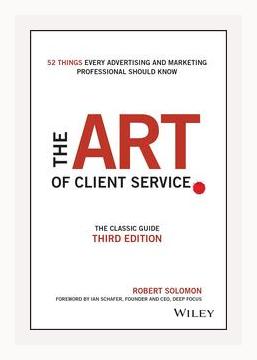Marketing and SalesAdvertising
“The Art of Client Service” by Robert Solomon is an essential read for anyone working in advertising, marketing, or any client-facing role. Written in 2003, the book breaks down the complex nuances of managing client relationships effectively and offers actionable advice to ensure client satisfaction and retention. This summary provides an organized review of the book, extracting key points and specific actions that can be applied to real-world situations.
Introduction
Robert Solomon frames the importance of client service as a blend of art and science. He asserts that while creativity and strategy are crucial, the backbone of a successful client-business relationship is exceptional client service.
Chapter 1: The Importance of Understanding the Client
Solomon emphasizes the significance of genuinely understanding the client’s business, market, and competitors. A lack of understanding here can lead to misaligned expectations and poor service.
Action:
- Conduct thorough research on a client’s industry, history, and market positioning before the first meeting. Use this information to tailor your initial conversations and build rapport.
Chapter 2: The First Meeting
The first meeting sets the tone for the entire relationship. Solomon advises preparing meticulously and suggests being punctual and professional.
Action:
- Prepare a detailed agenda for the first meeting and circulate it in advance. Follow up after the meeting with a summary of what was discussed and next steps.
Chapter 3: Building Trust
Trust is the cornerstone of any successful relationship. Solomon outlines that trust is gained through consistency, reliability, and transparency.
Action:
- Be consistent in your communication and always deliver on your promises. If an unforeseen problem arises, communicate it transparently and offer solutions.
Chapter 4: The Art of Listening
Listening to clients actively and empathetically is another key aspect. Solomon insists that understanding a client’s needs and concerns provides the foundation for excellent service.
Action:
- Practice active listening techniques during meetings, such as summarizing the client’s key points back to them to ensure you’ve understood correctly.
Chapter 5: Responding to Feedback
Responding to feedback, especially negative feedback, requires a level-headed and proactive approach. Solomon provides examples of how companies have turned negative feedback into opportunities for growth.
Action:
- Develop a feedback response plan that includes acknowledging the feedback, assessing its validity, and informing the client about the steps you’ll take to address their concerns.
Chapter 6: Managing Expectations
Managing client expectations from the get-go is critical to maintaining a healthy relationship. Solomon notes that over-promising can lead to disappointment.
Action:
- Set clear and realistic expectations from the outset, detailing what can and cannot be achieved within certain timeframes and budgets. Revisit these expectations regularly.
Chapter 7: Communication
Effective communication ensures that both parties are aligned. Solomon stresses the need for clear, concise, and regular updates.
Action:
- Create a communication calendar that includes regular updates and check-ins with your client. Use multiple channels like email, phone calls, and face-to-face meetings to keep the client informed.
Chapter 8: The Pitch Process
Solomon outlines the importance of a well-executed pitch and the preparation that goes into it. He notes that understanding the client’s needs and tailoring your pitch accordingly can make a significant difference.
Action:
- Invest time in creating a pitch that specifically addresses the unique challenges and goals of the client. Practice delivering the pitch with your team to ensure a smooth presentation.
Chapter 9: Handling Crisis Situations
Crises are inevitable, and how you handle them can make or break the client relationship. Solomon provides examples of companies that navigated crises successfully by maintaining transparency and acting swiftly.
Action:
- Develop a crisis management plan that outlines steps for identifying, addressing, and communicating during a crisis. Share this plan with your client to build confidence in your preparedness.
Chapter 10: Adding Value
Solomon argues that continually adding value beyond the client’s expectations can distinguish you from competitors.
Action:
- Identify areas where you can provide additional services or expertise that align with the client’s strategic goals. Regularly propose new ideas and solutions that can help the client achieve their objectives.
Chapter 11: Case Studies and Real-world Examples
Throughout the book, Solomon provides various case studies that illustrate successful client service practices. These examples highlight how different companies have applied the principles discussed.
Action:
- Analyze case studies relevant to your industry and implement best practices that have been proven to work. Learn from both the successes and failures of others.
Conclusion
In conclusion, “The Art of Client Service” by Robert Solomon offers a comprehensive guide to building and maintaining strong client relationships. The actionable advice provided can be applied across different industries and roles, ensuring that clients receive the highest level of service possible.
Summary of Actions to Take:
- Conduct Research – Understand the client’s business and market before initial meetings.
- Prepare Thoroughly – Create and circulate meeting agendas in advance.
- Build Trust – Be consistent, reliable, and transparent in all interactions.
- Practice Active Listening – Summarize key points during meetings to ensure understanding.
- Respond to Feedback – Have a feedback response plan and communicate actions taken.
- Set Realistic Expectations – Clearly define what can be achieved and revisit expectations regularly.
- Communicate Regularly – Maintain a communication calendar for regular updates.
- Tailor Your Pitch – Customize pitches to address the unique needs of the client.
- Develop Crisis Plans – Create and share crisis management plans with your client.
- Add Value – Look for opportunities to go beyond what’s expected and offer additional insights.
- Learn from Examples – Implement best practices from relevant case studies.
By integrating Solomon’s advice into everyday practices, professionals can enhance their client service skills, driving better outcomes for both clients and their own organizations.
